Low maintenance front garden ideas – the myths and the truth
A good low maintenance front garden will lift your heart every time you open your front door.
It’ll cheer up the neighbourhood, too – your front garden is part of everyone’s walk home. And, of course, it’s famously good for the value of your property.
Our front garden has been amazingly low maintenance. And I think it has also been beautiful. I can say that because I had no part in its design. It was created by our predecessors in this house.
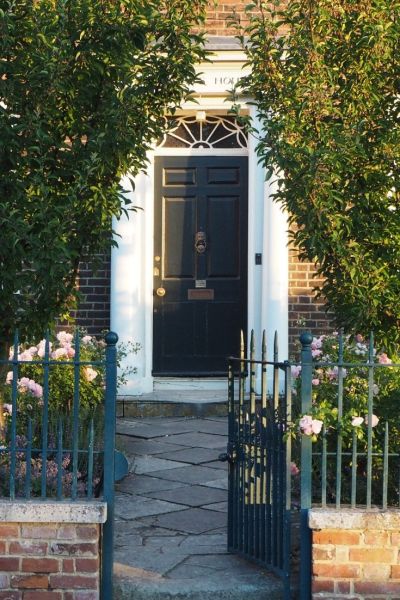
The only element we planted here are the two Malus hupehensis crab apple trees on either side of the gate.
And over the eighteen years we’ve lived here, it has continued to blossom and flourish with minimal input from me.
So I’ve rounded up all the advice I can find on low maintenance front gardens. And, using my experience of having a truly low maintenance front garden, I will assess each tip as being a ‘myth’ or a ‘truth.’
If you prefer to see a video, here is the link to the Middlesized Garden YouTube channel’s Low Maintenance Front Garden Tips.
One important principle with front garden design is that it should echo or complement the architecture of your house. So have a think about that first. Low maintenance front gardens can come in any style. So there are some different styles of front garden here.
The complete low maintenance front garden
- No more than five or six different types of plants
- Choose small trees, shrubs, roses and bulbs. No perennials, annuals or bedding plants
- Choose plants with different flowering seasons.
- Colour theme it. Only one or two colours as well as green.
- Artificial grass requires cleaning, weeding and some other maintenance. Check care instructions before deciding whether it’s for you.
- Pebbles, shingle, stone and gravel will also require some weeding. There is no such thing as a ‘maintenance-free surface’.
- Pay attention to drainage and planting if you have a front garden parking area
- Garden pots are always more work than planting in the ground.
- If you want a climber, just choose one. It will need some maintenance, usually just clipping two or three times a year.
- Small trees need very little maintenance. Plant them three quarters of their eventual height away from the house. See here for the best trees for small gardens.
1) Limit your plant choices – true
Once you’ve decided on the overall style for your front garden, it’s time to think about specific plant choices.
Both House Beautiful’s and Ideal Home’s posts on low maintenance front gardens start with saying you should limit your plant choice. Choose just five or six different plant varieties for an easy-care front garden.
This is an excellent piece of advice. A row or group of the same plants looks really effective and is easy to look after, provided you choose the right plants.
The reason why this works is that each plant has a slightly different care routine. So if you have 50 plants in your garden, you may have 50 different care routines. If you have six, then it may be just six different routines.
Looking at our front garden, I can see that part of its success is that it was designed with only six different types of plant.
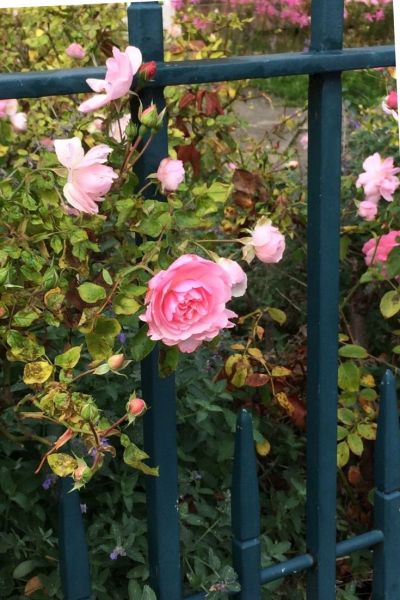
These Rosa ‘Bonica’ line our front path and also run along the railings. Our home is sometimes referred to by locals as ‘the house with the roses’.
Our predecessors lined the path and the fence with roses. They added nerines along the front of the house. And they planted three pairs of shrubs on either side – spirea, viburnum and another larger rose. They also planted some daffodils, which I have since replaced with tulips.
We have added some plants. We underplanted the roses in the front with Nepeta ‘Six Hills Giant’ and along the path with a pink Teucrium. Neither are entirely necessary, although the Nepeta makes a beautiful contrast in high summer. And when anyone gives me a potted pink cyclamen, I plant it in the front garden when it’s over because cyclamen never gets in the way.
And choose your plants for a long season of interest…
If you only have five or six different types of plants in your front garden, make sure they all flower at different times.
We get winter blossom from Viburnum ‘Bodnantense’. In spring there were daffodils and there are now tulips.
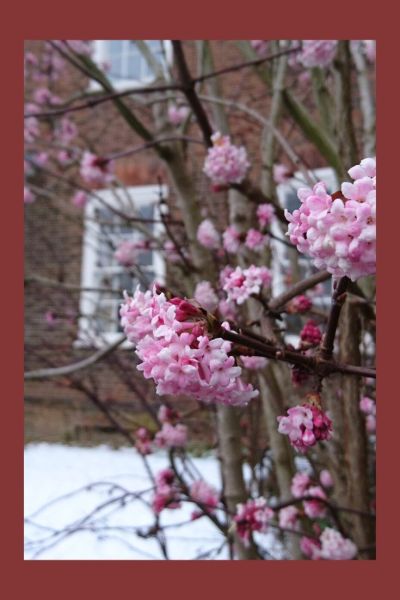
This Viburnum x bodnantense ‘Dawn’ flowers throughout the winter and looks so beautiful in snow.
In late spring, there are plumes of spirea blossom. This is followed by the crab apple blossom, which is truly stunning.
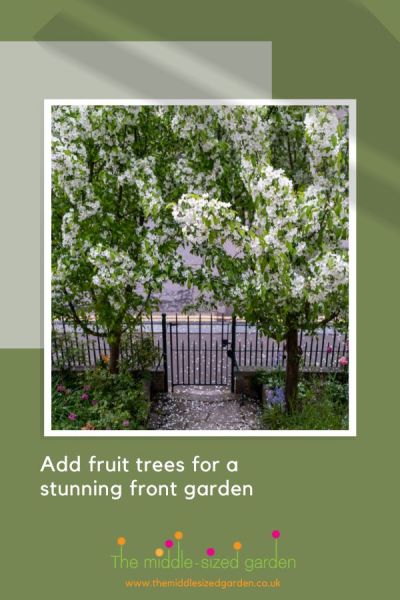
Fruit trees, such as our crab apples here, add impact with spring blossom and autumn fruits
And in June, the roses lining the path and fence flower effusively. We clip away the dead heads with shears in July, and get a smattering of blossoms until Christmas.
Apart from this clipping, the only other treatment they need is an application of well rotted manure or compost around the roots in autumn.
Tip: Choose repeat flowering roses for a long season. Ours are ‘Bonica’ and they have flowered with regularity. They also seem to stay fairly healthy – check whether the roses you choose are reasonably resistant to black spot, mildew or rust. They also have good rose hips in winter.
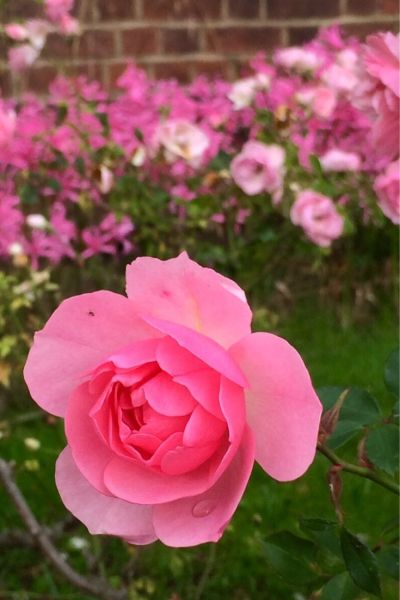
These repeat flowering Rosa ‘Bonica’ have a lavish first flush in June, followed by a steady second flowering between August and Christmas. The nerines are in the background.
And in October, when the roses’ flowers are beginning to slow down, the pink nerines come out, getting lots of compliments.
Tip: Nerines are a plant that dislikes disturbance. It’s much happier in a border on its own. If you have a low maintenance front garden, the chances are that you’ll hardly ever do any digging, so it’s a brilliant spot for nerines. They can be tricky in mixed borders. But it can also take a couple of years before they really show off, so give them time.
2) Hardy perennials are easy to look after…myth?
I found several posts advising you to plant hardy perennials because they’re easier to look after. If you’re not sure what perennials are, see Perennials Made Simple.
While it’s true that perennials need less attention than annuals and bedding plants, shrubs are the only truly low maintenance plants.
I introduced a hardy perennial (Nepeta ‘Six Hills Giant’) to our front garden. Like many perennials, it does need to be lifted and divided every few years or it starts to sprawl.
If you forget (we did), then it’s very hard work to dig up a huge clump. And it also requires trimming and dead heading, although shrubs, too, will need some pruning once a year.
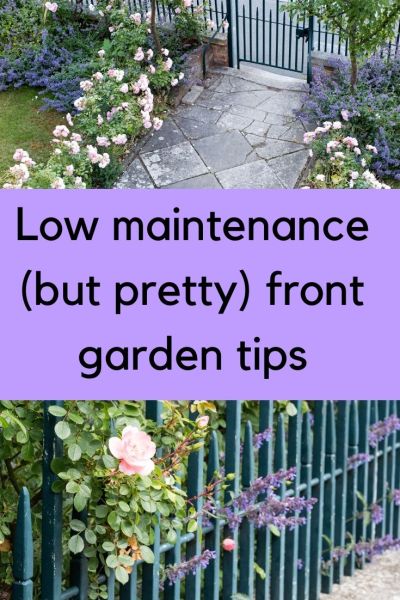
The blue flowers above show the Nepeta ‘Six Hills Giant’ we planted. They are reasonably low maintenance, but adding them has increased the work in maintaining the front garden. So it’s a question of balance when planning at low maintenance front garden.
Other perennials may need staking (delphiniums), protecting from slugs (hostas) or lifting to protect from frost (dahlias).
If you really want a truly low maintenance front garden, stick to small trees, shrubs, roses and bulbs. Don’t plant perennials, annuals or bedding plants.
There are specific easy-care plant choices in brilliant low maintenance plants for beautiful gardens and 10 low maintenance plants for instant garden success.
3) Pick a colour theme
Limiting yourself to just one or two colours in the front garden looks great. Our predecessors chose pink. We’ve added blue with the Nepeta, which is pretty, but is a little more work. It’s all a question of balance.
All our flowering shrubs, with the exception of the spirea, are pink. That might sound like over-doing it, but the different plants all flower at different times.
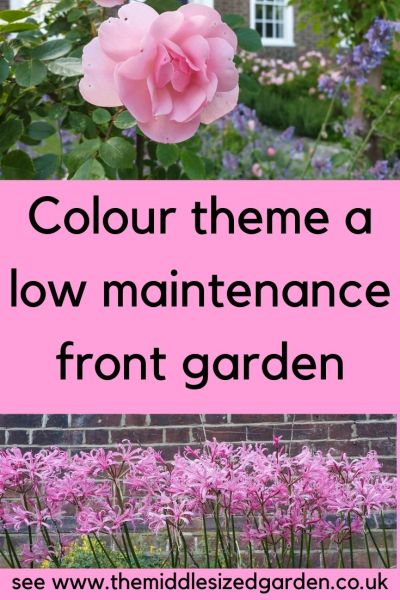
Colour theming is an effective way of creating a low maintenance garden.
You may wonder why the colour theme makes it easier to look after. Technically it doesn’t, but it does make a low maintenance front garden look smarter, which is important.
4) Is artificial grass low maintenance?
You may be tempted to think that artificial grass will give you a low maintenance front garden. But it’s important to look into this carefully before deciding whether to buy it or not.
Everything needs some maintenance. So check what maintenance each option needs. Then decide whether you are happy to do that kind of work.
Fellow blogger and vlogger Lee from Garden Ninja has done an in-depth look at fake turf. He says that anything that lands on it will have to be cleared away by you. That includes leaves in autumn, tree blossom in spring and pet poo from foxes or neighbourhood cats.
Of course, you would also have to clear this away from stone, brick or gravel. But if you are busy and don’t get round to it immediately, the leaves, blossom etc won’t damage the stone or brick, whereas they can lead to staining or mould build-up in artificial grass. And on a natural lawn, leaves, blossom and even pet detritus will break down naturally and gradually be re-absorbed.
I have seen threads on gardening Facebook pages about how to get the smell of dog urine out of artificial grass. If you have more than one dog, this is certainly worth thinking about.
And rain largely drains through artificial turf, but some can get trapped, leading to outbreaks of mould. If your house is on a flood plain, artificial turf is not advised.
All this means that there are now lots of products available to ‘cleanse, protect and sanitise’ your artificial grass. It’s worth checking them to see if this sort of maintenance is for you.
You still have to weed artificial grass
Artificial grass is laid over a weed suppressant membrane as well as some hard core. However, that doesn’t stop weed seeds from landing on the surface after the first few months.
There are several front gardens with artificial grass near me. One is regularly weeded, although it does usually have some weeds sticking out. The other hasn’t been weeded for two years, and is now completely overgrown with brambles and other weeds.
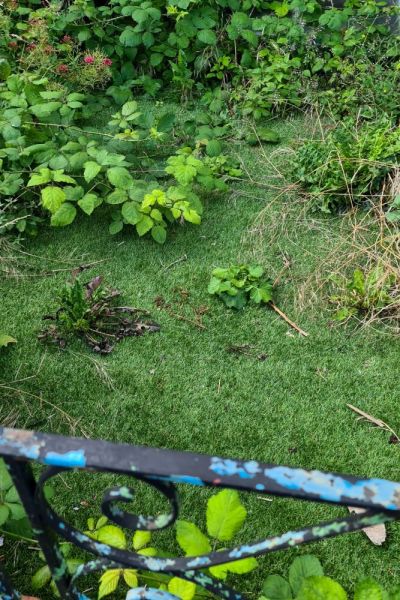
One of the front gardens near me, laid with artificial grass. It hasn’t been weeded, so it has been over-run with weeds.
If you have a natural grass lawn, you can get rid of many weeds by mowing before they’ve had time to flower and set seed. Weeds will also settle on other surfaces, such as stone and brick, but it’s harder for them to get established.
Lee also says that most fake turf suppliers recommend a light raking over, with the addition of some extra sand, around every six months. You don’t have to do this with other garden surfaces.
Artificial grass doesn’t necessarily save water
Manufacturers say that artificial grass saves water because you don’t have to water the lawn. However, very few people now water their lawns in the UK. A brown lawn isn’t dying, it’s just saving energy by going dormant. It will happily turn green again when the rains come.
There has been a great deal of coverage about the environmental impact of artificial lawns. They’re essentially plastics or petroleum based products, although some are made from recycled materials. However, there are very few facilities that can recycle the artificial grass when it’s lifespan is over, so it will go to landfill. Most artificial grass is guaranteed for 10-15 years, but it can start to look shabby before that if you don’t look after it. So you’ll need to factor in the replacement cost every 10 years or so.
Living lawns are also part of the eco-system, supporting wildlife. They absorb pollution and carbon dioxide. Artificial grass doesn’t.
5) So is there a low maintenance front lawn option?
We have two small squares of lawn on either side of our front path. And these need mowing in the summer. It’s a small area, so it doesn’t take long. And we can do it with a hover mower. We let fallen leaves and blossom break down and be re-absorbed into the earth. Mr Middlesize also takes a dandelion weeder to the lawn before he mows it.
Of course, many people prefer a really smart green lawn, and this will need more treatment. You would probably spend a few hours twice a year to scarify, aerate, feed, weed or re-seed, as well as the weekly mowing.
I spoke to leading lawn expert David Hedges-Gower on how to have an easy care lawn. He said that a lawn cut by robot mower is probably the easiest. A robot mower cuts the lawn regularly so it never gets very long. You don’t need to clear up the clippings because they’re reabsorbed into the lawn, feeding it. This would really be an almost maintenance-free lawn.
However, I don’t think you’d want a robot mower in a front garden, because of the possibility of theft.
No-mow ‘meadow’ front lawns
We’ve been experimenting with a ‘no-mow’ meadow in our two small squares of front lawn. Once again, this isn’t as easy as just not mowing your lawn. You do need to do some maintenance, but you don’t need to do weekly mowing. It can look untidy, although it can also look pretty.
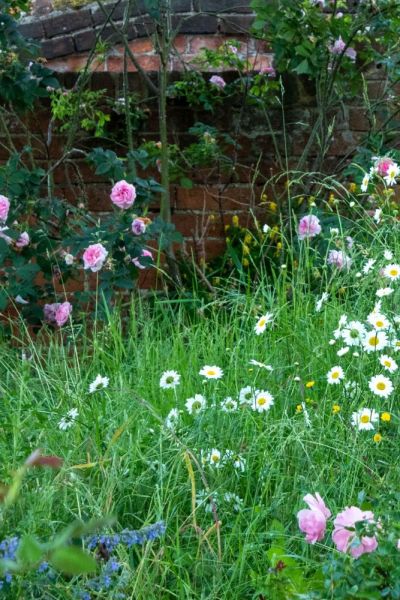
This is a section of our mini meadow front lawn. It has looked pretty at times, but it can also look untidy. However, it is wonderful for wildlife and very easy to look after.
If you’re interested in creating a mini meadow lawn, see this post. And here are also some meadow lawn mistakes.
6) Low maintenance front garden ‘hard-scaping’
Many front gardens locally have covered their front planting areas in pebbles, slate, gravel or shingle.
These will need less maintenance than a small patch of lawn, but they will need some care. Gravel, for example, gets very weedy after a few years, even if it laid over weed-suppressing membrane. To a lesser extent the same goes for pebbles and slate. Nature is very determined!
It is also worth thinking about your weather, climate and which way your house faces. Our house is East-facing and gets very hot on summer mornings. If we had gravel, stone, pebbles – or artificial grass, which gets very hot, too – all over our front garden, it would retain and reflect the heat.
Our two crab apple trees give the house welcome shade and stop it getting too hot in summer. In winter, they lose their leaves, so they don’t cast shade.
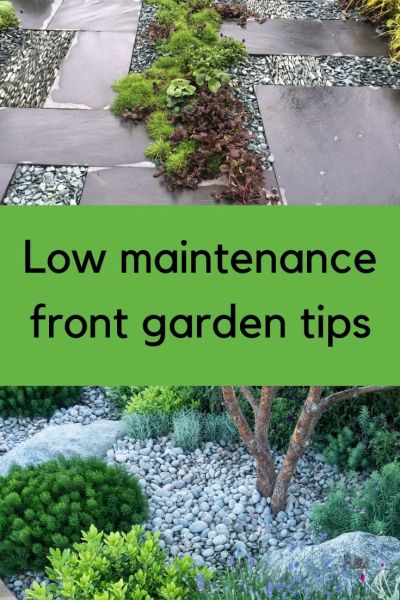
Pebbles and slate are often used in front gardens to reduce maintenance. They look smart, but don’t forget that every surface will need some care.
Equally, a completely hard-surface front garden could make a West-facing house hotter in the evenings or overnight. A lawn or planted border is cooler in summer than a hard surface.
And many of these shingle, slate and pebble front gardens are only just being installed. They will certainly be lower maintenance in the first few years. In a few years time, we shall find out if they have significant long-term disadvantages.
6) Low maintenance paths and driveways…
Once again, all surfaces will need some maintenance. Always find out what that involves. You may have to dig about a bit. The companies selling the stones, pebbles or shingle may not be completely straightforward about this.
I’ve done a post on how to choose garden path materials, which may help. Our garden path is stone, probably laid in the 18th century. So stone is expensive but long-lasting. We weed around the pavers two to three times a year.
Many parking areas and driveways are paved over as one continuous surface, with concrete or with cement pointing between the pavers. You will get fewer weeds that way. They will need hosing down or power-washing from time to time. They can get slippy if you let leaves or algae hang around on them.
However, a solid continuous driveway or path also means that water has nowhere to go when it rains. Gaps between the paving improves water run off. That’s good for the environment – and it also means less water hanging around on your path or driveway.
Your installers will add a drainage bar at the bottom of your path or driveway. Water will pour over your driveway and into the drainage system, increasing the likelihood of localised flash flooding. But you’re still going to have more water running over your hard surface, encouraging algae and perhaps making it slippy. There are also legal restrictions on impermeable paving, which you need to check for your area.
7) Low maintenance vs environmentally-friendly front garden
People used to think that wildlife gardens or environmentally friendly gardens had to look untidy. But we now know that’s not necessary.
Our front garden is buzzing with several different kinds of bees, including ground-dwelling bees in the lawn. There’s always a blackbird family. And the sparrows argue over space in the spirea and viburnum. Dragonflies and Red Admiral butterflies flutter across our front path in summer. But the design is quite formal and controlled.
It is wildlife friendly because it was designed to flower for as much of the year as possible. This alone creates a valuable resource for bees or pollinating insects. It’s worth checking whether plants are ‘good for pollinators’ when you buy them. Shrubs and trees also create habitat for birds.
Completely paved-over front gardens are damaging to the environment, particularly in towns and cities where air quality and water run off is an issue. The biggest issue in towns and cities is the paving over of front gardens to turn them into parking spaces. This has created more flash-flooding and has significantly reduced wildlife habitat.
But you can still have an environmentally-friendly front garden parking space – The RHS has lots of advice on how to combine parking areas and planting. For example, getting rid of your fence and having a hedge instead will improve air quality, help prevent flash flooding and offer a wildlife habitat.
But a paved-over front garden will be lower-maintenance. Just realise that it won’t be no-maintenance. You’ll still have to look after it. And you may think that a few hours extra effort a year is worth it for the environmental reasons.
8) Low maintenance front garden climbers?
You can increase the greenery in your front garden with a climber. That will help improve air quality and benefit wildlife. It makes buildings look more beautiful.
And if it spreads across your walls, it can provide valuable insulation. The back wall of our house is covered in summer with Parthenocissus Henryana or Chinese virginia creeper. During a heat wave, the rooms protected by the creeper are noticeably cooler than those without climbers on the outside walls.
But climbers aren’t ‘low maintenance’. Some spread too far too fast and others require training. We have to clip our Virginia creeper back two to three times a year. Ivy grows more slowly and needs very little attention, but it can pull down guttering if you let it get out of hand.
Many houses had climbers and creepers growing up them but by the 1990s, people had mostly taken them down. Builders and decorators don’t like working around them. And people often believe they’ll damage the house in some way.
But now there’s increasing evidence that the right climbers, grown properly, can help protect the house from heat, cold and wind. And that they won’t damage brickwork which is in good condition. And they look beautiful. See here for more advice on how to choose a climbing plant.
If you grow climbers up your front wall, you will need to clip, prune or train them in some way. So they do require some maintenance. And don’t buy several different types, especially if they need different pruning times. You’ll end up with a tangle of climbers all needing to be pruned at different times.
9) Low maintenance pots in the front garden?
All pots require maintenance. I did see a post suggesting that you buy plants in flower and drop them into your ornamental pots without re-potting them. But these will still need watering and dead-heading. And they’ll need replacing every 5-6 weeks.
I’ve never had pots in this front garden. It’s fine without them, I think.
There’s a post here on low maintenance pots. If you do want pots in your front garden, it has some good suggestions. But if you really want a low maintenance front garden, don’t have pots.
10) Trees and low maintenance front gardens
Trees are very low maintenance. Everything, of course, does need some care. So trees will need some pruning once a year or once every few years.
Trees make a street look more elegant. They offer habitat to wildlife. They improve air quality in urban streets. And they can help protect your house from wind, hot or cold, depending on which trees you choose and how you place them.
Find out which trees are best for small gardens in this post, with advice from the award-winning garden designer Jamie Butterworth.
There are some garden trees with good autumn colour in this post.
The only truly successful plants we have added to our front garden is two Malus hupehensis (Crab apple trees) on either side of the front gate. A friend planted them from a pip in 2010 and gave them to me in small pots. They really have a presence, and I have spotted Instagram posts of them framing the front door. They have spring blossom, autumn colour and tiny red fruits. Every winter I remove one or two branches if they aren’t growing in the right direction.
Read this post if you want trees for privacy in your front garden.
Shop my favourite garden tools, products and books
I like to garden in as sustainable and wildlife friendly way as possible, and that extends to the Middlesized Garden t-shirts, hoodies and tote bags. If you’re looking for t-shirts and hoodies made of natural materials with renewable energy and delivered in plastic free packing, check out the Middlesized Garden Teemill store. I also find them stylish and easy to wear, and I hope that the slogans will trigger some interesting gardening conversations!

This is the stone blue version of the ‘Gardeners Learn by Trowel & Error’ hoody. Ever since it arrived, I’ve worn it more than almost anything else, because it’s soft and comfortable.
I’m often asked for recommendations, so I have pulled together the products I use on the Middlesized Garden Amazon store. Links to Amazon are affiliate which means I may get a small fee when you click on them, but I only recommend books, tools and products I really believe you will like.
For example, my list of gardening essentials includes both the heavy duty and light gloves I find best, a kneeler, some recyclable pots, the knee pads I use and a very useful garden trug.
Pin to remember low maintenance front garden tips
And do join us for a free weekly email with garden tips, ideas and inspiration.
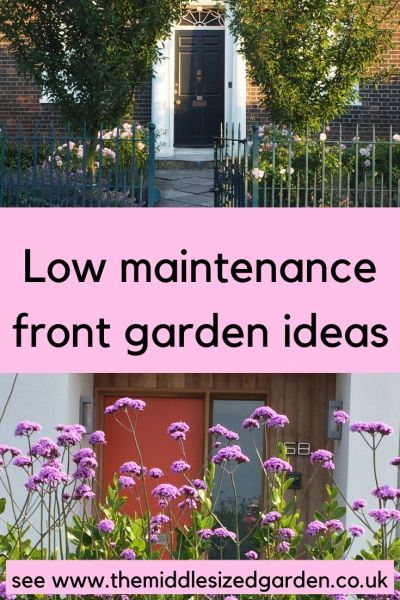
























i,
I’ve got a completely empty bed in my front garden having removed a large holly tree last year. It’s south facing with a low wall along the pavement and a large area for parking. It’s triangular in shape. Having removed the holly we were thinking of putting back in a flowering tree (such as Prunus x Subhirtella and perhaps an Acer Palmatum but after that I’m stumpted. My neighbour (who we are attached to) is planting flowering perennials but I’m not sure that’s the right thing for a low maintenance garden. I’d love some suggestions.
There is some interesting advice from the RHS on planting up front gardens which have parking: https://www.rhs.org.uk/advice/profile?PID=879 and I also think it’s worth taking a notebook or smartphone round your neighbourhood and either noting down or photographing front gardens you like. If the gardens are local to you, the chances are good that those plants will do well, although the only difference is whether they have a sunny south-facing garden, a shady north-facing garden or something in between, as how much sun would affect how well certain plants grow. Definitely a great idea to have a tree, they are so good for the environment and add scale and vertical interest to a front garden. I hope that helps.
Your front garden is so beautiful, I can see why other people take photos of it. I’m very keen to redesign my front drive but I am stumped. One of the main features of your garden is that it is symmetrical. My own drive has a low wall along half of it and the other half is open to use as a driveway. The drive and house are quite wide but the front door is right in the corner. Any planting scheme I’ve thought up seems completely unbalanced. I also struggle a little with knowing how plants will cope with the changing conditions. The drive slopes downwards and is north facing, so the top of the drive is in the shade of the house during winter but in full sun in summer as the sun is higher. I’m not an experienced gardener so don’t always understand what plants will be able to grow here. Do I look for labels saying full sun or partial shade? Neither seem right.
Thank you. I think it’s a good idea to look for plants that say that plants will do well in shade or partial shade as North-facing means your drive will get less sun than most gardens. Even when there is full sun in summer, it probably isn’t for a full eight hours, which is what a ‘sunny’ position means. Sometimes it’s a question of trial and error and you may find some plants do surprisingly well in shade, but others don’t. In terms of design, it’s difficult to say, but one idea would be to use taller plants along the boundary and reducing the height of the plants as they get closer to the drive. You could punctuate this with a few taller, ‘see-through’ plants dotted throughout, such as grasses. I think you perhaps shouldn’t worry about ‘balance’ or symmetry as it’s not possible. One thing you might consider on a slope is to visit or look at rock gardens and see if you can get inspiration from there. Rock gardens were very popular in the 1950s and now there are very few around, but I think they are reviving to a certain extent. And they make great sense of a slope. I hope that helps.